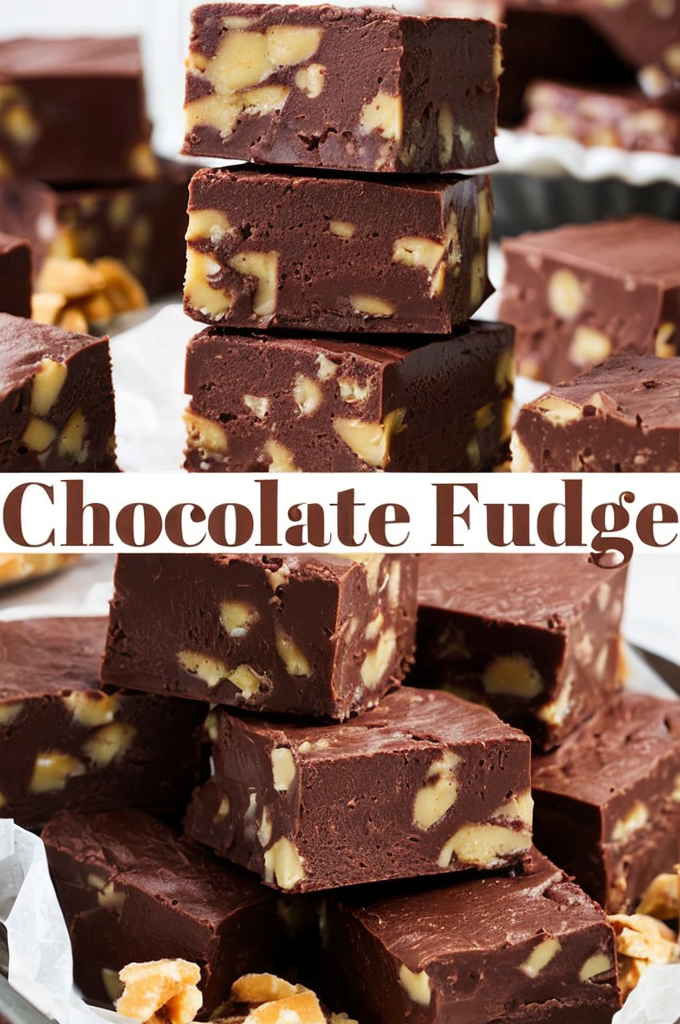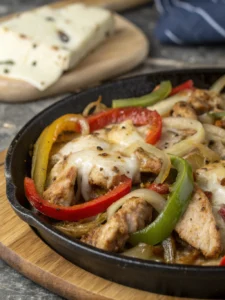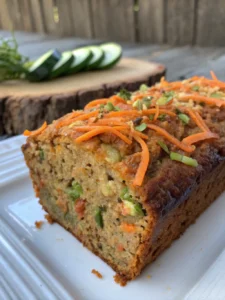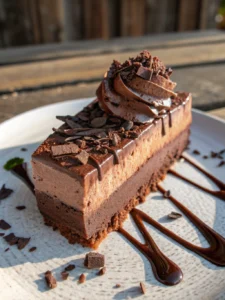Easy Foolproof Chocolate Fudge: Indulge in Sweet Simplicity
There’s nothing quite like the rich, creamy indulgence of chocolate fudge, and our Easy Foolproof Chocolate Fudge recipe is here to satisfy your sweet cravings without the fuss. Whether you’re a seasoned confectioner or a novice in the kitchen, this recipe is straightforward and uses only five simple ingredients. The delightful medley of rich chocolate, smooth texture, and a hint of vanilla creates an irresistible treat that’s perfect for any occasion. Dive into the decadent flavors of this timeless dessert and discover how easy it is to make with ingredients you likely already have in your pantry.
Quick Recipe Highlights
- Flavor Profile: This chocolate fudge boasts a deep, rich chocolate flavor with a subtle hint of vanilla and a balancing sweetness that is sure to satisfy any sweet tooth.
- Texture: The fudge is smooth and creamy, with a melt-in-your-mouth quality that leaves you wanting more.
- Aroma: The enticing aroma of chocolate with a whisper of vanilla is comforting and inviting, making any kitchen feel like a cozy candy shop.
- Visual Appeal: A luscious, glossy finish with a dark chocolate hue, perfect for showcasing at parties or as a gift.
- Skill Level Needed: With minimal steps, this recipe requires no special candy-making skills, making it ideal for beginners.
- Special Equipment: While no candy thermometer is needed, a deep saucepan and a sturdy spatula or wooden spoon are beneficial for mixing.
Recipe Overview
- Difficulty Level: The simplicity of this recipe is perfect for those new to candy-making. By minimizing the steps, you’re almost guaranteed success, regardless of experience.
- Category: This chocolate fudge recipe falls under the dessert category, easily serving as a sweet finale to any meal or as a delectable treat throughout the day.
- Cuisine: Drawing from classic American dessert traditions, this fudge has become a staple in sweet offerings across the nation, celebrated for its glorious simplicity and rich flavor.
- Cost: With only five ingredients and no need for specialized components, this recipe is easy on the wallet, making it an economical choice for families and gatherings.
- Season: Although fudge is popular year-round, its comforting taste makes it particularly favored during the fall and winter months, alongside holiday celebrations.
- Occasion: The versatility of this fudge makes it perfect for holiday parties, gift baskets, bake sales, or as a little midweek pick-me-up.
Why You’ll Love This Recipe
The taste of this chocolate fudge is rich and satisfying, striking a perfect balance between the deep flavors of chocolate and the subtle sweetness that accompanies it. Each bite offers a smooth and creamy texture that will dissolve effortlessly in your mouth, delivering an immediate sense of indulgence.
Preparing this chocolate fudge is incredibly convenient, requiring minimal time and few ingredients. The process is straightforward, ensuring that the fudge comes out perfectly every time. This is particularly appealing for busy individuals looking for a quick yet impressive dessert option.
Nutritionally, this fudgy treat can be adjusted to accommodate various dietary needs. By choosing high-quality chocolate or opting for dairy-free alternatives, you can tailor the recipe to fit better lifestyle choices, ensuring that everyone at the table can enjoy it.
For social gatherings and entertaining, this chocolate fudge is a hit. Its classic flavor profile is universally appealing, and it pairs well with a variety of beverages and desserts. Whether as a centerpiece for a dessert platter or as a closing bite, it never fails to impress.
Cost-effectiveness is another highlight, as the basic ingredients are typically affordable and easy to find in any grocery store. Using what you already have at home without the need for exotic or expensive additions makes this recipe incredibly accessible for budget-conscious cooks.
Historical Background and Cultural Significance
Chocolate fudge has a rich history rooted in American culinary traditions, with its origins traced back to the late 19th century. As it gained popularity, fudge became a staple at local fairs and confectionery shops, valued for its simple preparation and rich taste.
The cultural importance of fudge is evident in its presence in nostalgia-driven treats and holiday traditions across the United States. Many families pass down their own versions of fudge recipes through generations, making it an enduring symbol of comfort and home.
Over the years, the recipe for fudge has evolved, with modern variations ranging from nut-studded versions to those infused with flavors like peppermint and peanut butter. Despite these adaptations, the classic chocolate version remains a beloved favorite.
Regional variations of chocolate fudge can be found throughout the country, with some states hosting festivals dedicated to the celebration of this cherished dessert. These variations highlight local ingredients or incorporate unique techniques, reflecting the diverse cultural landscape of America’s confectionery scene.
Ingredient Deep Dive
Chocolate forms the heart of this fudge, often selected for its rich and versatile flavor. Historically, chocolate has been a cherished ingredient since its ancient use by the Mayans, revered for its enhancing properties in various culinary creations. When choosing chocolate, opt for high-quality options to ensure a luscious end result.
The condensed milk serves as the sweetening agent and provides a creamy consistency. Originating as a staple in American pantries since the early 20th century, its thick, sweet nature has made it indispensable for many dessert recipes. Always store it in a cool, dry place and refrigerate after opening.
Butter adds richness and helps create a smooth texture in the fudge. Whether you use salted or unsalted butter can subtly change the flavor profile, but both work well based on personal preference. To maintain freshness, butter should be stored in a fridge, wrapped to prevent absorption of odors.
Vanilla extract introduces delicate floral notes that complement the chocolate without overpowering it. This staple in baking is derived from vanilla beans and boasts a storied history as a luxury spice. Ensure to choose pure vanilla extract for the best flavor and store it in a cool, dark place.
A pinch of salt magnifies the sweetness and enhances the depth of the chocolate flavor. In baking, salt functions as a flavor enhancer, balancing out the sweetness of desserts. A simple yet effective ingredient, salt should be stored in a dry environment to prevent clumping.
Common Mistakes to Avoid
- Failing to properly melt the chocolate can result in a gritty texture. Always use low heat and stir continuously to avoid scorching.
- Not using fresh ingredients, especially expired condensed milk or vanilla extract, can affect the taste adversely. Always check the freshness before use.
- Skipping the lining of the pan can make fudge removal difficult. Use parchment paper for easy lifting and portioning.
- Under-mixing the ingredients can result in uneven flavor distribution, so ensure a thorough blend for consistent taste.
- Overcooking can turn the fudge crumbly. Stick to the cooking time and use a timer to ensure accuracy.
- Adding too much salt can overpower the sweetness. Start with a small pinch and adjust to taste if necessary.
- Failing to cool the fudge properly can lead to improper setting. Allow it to cool at room temperature before refrigerating.
- Cutting the fudge while warm can cause it to lose shape. Ensure it’s fully set before slicing for neat portions.
Essential Techniques
Achieving the perfect chocolate melt is crucial for smooth fudge. Use a double boiler method or low heat to prevent chocolate from burning, stirring continuously until fully liquid. This safeguards against lumps and maintains a uniform texture throughout your fudge.
Integrate ingredients thoroughly by mixing well after chocolate melts. Consistency is key to avoid pockets of flavoring, ensuring each bite is equally rich and delectable. This step significantly influences the overall mouthfeel and taste of the fudge.
Setting the fudge involves allowing it to cool gradually. After pouring the mixture into a pan, let it rest at room temperature to start solidifying, and then move it to the fridge. This gradual cooling helps form a stable, firm fudge without separation or layering.
Pro Tips for Perfect Easy Foolproof Chocolate Fudge
Allow ingredients to reach room temperature before starting, as this helps them blend seamlessly, resulting in a smoother mixture. This trick is especially useful when cutting down preparation time.
Experiment with different chocolate types such as dark or semi-sweet to tailor the fudge’s flavor. This customization can make each batch unique without altering the core structure of the recipe.
Use a non-stick saucepan with a heavy bottom to ensure even heat distribution and prevent sticking. This investment pays off in maintaining quality and ease of cooking.
Consider adding toppings such as nuts, sea salt, or shredded coconut post-pour to enhance flavor and texture. These embellishments elevate the presentation of your homemade fudge.
For a clean finish, line your baking dish with parchment paper. It prevents sticking and simplifies the transfer process from pan to cutting board.
If gifting, wrap individual pieces of fudge in wax paper with a personal note. Not only does this add a charming touch, but it maintains freshness and form stability.
Variations and Adaptations
Regional variations such as adding chili powder or espresso powder can introduce a unique twist, highlighting local tastes and preferences. Each variation imbues the fudge with a signature aroma and warmth distinctive to its origin.
For staunch seasonal adaptations, consider incorporating spices like cinnamon, nutmeg, or cloves during fall, aligning with seasonal flavors. This simple switch offers a warm, festive version perfect for holiday tables.
Dietary modifications can be achieved using dairy-free chocolate and condensed milk substitutes, making the recipe suitable for vegan diets. This allows a broader audience to indulge without compromising on taste or texture.
Experiment with flavors by adding unpredictable twists like orange zest or mint extract for added complexity. These minor amendments offer a refreshing take on the classic treat, welcoming innovation without straying from traditional appeal.
Texture modifications can be embraced through textural additions such as crushed cookies or chewing dried fruit, reminiscent of popular candy bars. This adds a playful harmony of crunch and chew to the otherwise creamy fudge.
For a modern serving suggestion, use silicone molds to create varying fudge shapes. This method not only diversifies presentation but serves personalized portions perfect for creative plating.
Serving and Presentation Guide
Plating fudge creatively can turn a simple dessert into a show-stopping treat. Consider arranging bite-sized pieces in a circular pattern or pyramid shape to add height and visual appeal to your dessert table.
Garnishing ideas like a sprinkle of sea salt or a dusting of cocoa powder can add an elegant touch, enhancing both taste and presentation. This finishing step sets a sophisticated tone for your sweet treat.
Traditional accompaniments such as pairing fudge with fresh fruit can balance its richness. Consider serving alongside strawberries or raspberries to add a refreshing contrast to the dense chocolate.
More modern serving suggestions involve placing fudge on a dessert board with assorted nuts and fruits, creating an inviting spread fit for a feast. This encourages guests to mix and match flavors as part of a communal dining experience.
Serving this fudge at room temperature is ideal, as it brings out the intensity of the chocolate. Consider taking it out of the fridge a few minutes before serving to achieve optimal taste and texture.
Remember portion control tips when serving, as this rich dessert is best enjoyed in moderation. Cut small, even-sized squares to ensure everyone receives the right amount of indulgence without overwhelming sweetness.
Wine and Beverage Pairing
For chocolate fudge, wines like a robust Zinfandel or a creamy dessert wine such as a Muscat are excellent choices. Their bold and sweet nature harmonizes beautifully with the chocolate, providing a tantalizing balance.
Non-alcoholic alternatives like sparkling water with a hint of lime can cleanse the palate, offering a refreshing complement to the dense richness of fudge. This pairing is superb for those preferring lighter, fizzy options.
Pairing the fudge with a strong espresso or dark roast coffee can enhance its flavor profile, deepening the chocolate’s intensity while providing a brisk contrast. This pairing is ideal for an afternoon pick-me-up.
Serving suggestions for these beverages should consider optimal temperatures: serve wines slightly chilled and espresso piping hot to enhance the sensory experience. This attention to detail enriches the entire tasting encounter.
Portion drinks appropriately considering the richness of the fudge, using small, elegant glasses for wine or coffee to promote moderation and savored enjoyment. This methodology ensures balanced, pleasurable indulgence.
Storage and Shelf Life
Proper storage methodologies ensure your chocolate fudge retains its delightful taste and texture over time. After preparation, place the fudge in an airtight container to lock in freshness and prevent drying out.
Temperature requirements suggest storing fudge at room temperature in a cool, dry area for about one to two weeks. For extended freshness, refrigerate it to last up to three weeks, accommodating for variable climatic conditions.
Ideal containers include sealed plastic or glass storage boxes that protect against external moisture and air exposure. Choose sizes that limit excess space to maintain an optimal storage environment.
Look for signs of spoilage such as changes in aroma, texture, or appearance. If the fudge becomes brittle or develops an off smell, it’s best discarded to avoid adverse experiences.
For extended storage, consider freezing fudge. Double-wrap in plastic followed by aluminum foil to shield against freezer burn and maintain taste for several months. Thaw gently in the refrigerator before serving to retain texture.
Make Ahead Strategies
The flexible nature of this fudge recipe makes it ideal for make-ahead scenarios. Begin by prepping all ingredients, measuring and organizing them for seamless flow into the cooking process when ready.
Store ingredients separately if not immediately combining, maintaining maximum freshness. Butter and condensed milk should be refrigerated, while chocolate and vanilla can remain in cool, dry storage.
Evaluate quality impact if preparing components in advance, noting flavors may meld more deeply over time. Initial trials can guide minor adjustments to ensure consistency over successive preparations.
Consider reheating options if necessary, using gentle, indirect heat methods to avoid changing fudge consistency. This is particularly useful if preparing several days ahead of a major event.
Assemble fudge shortly before planned serving for optimal presentation, taking extra care in slicing to showcase neatly cut, visually appealing squares. Balance the aesthetic with practical servings for maximum effect.
Always add fresh elements like garnishing just before serving, to preserve their vividness and aromatic profiles. This approach maintains an inviting, sensory-rich experience for your guests.
Scaling Instructions
To halve this recipe, meticulously halve each ingredient measurement, maintaining ratio integrity for balanced taste and texture. Be attentive to cooking times, which may slightly adjust due to reduced volume.
For doubling or tripling the recipe, ensure the cooking vessel accommodates increased quantities without risk of overflow. Stir with extra care over larger surfaces to ensure even heat and consistency.
Equipment adjustments may include larger pans or additional spatulas, supporting effective mixing and setting. Avoid overcrowding that can hinder temperature and precipitation control.
Timing often requires extension in scaling scenarios, especially related to cooking section durations, so remain observant to prevent burning or undercooking. A good practice is to extend based on volume increases proportionately.
Balance required storage adjustments by measuring increased recipe yield against available container space and adjusting for adequate preservation lengths and freshness.
Nutritional Deep Dive
A macro breakdown of this chocolate fudge highlights the substantial carbohydrate and fat content typical of dessert indulgences. Protein remains minimal but not without impact given the composition.
Micronutrient analysis reflects key highlights such as magnesium and iron from cocoa, contributing to dietary balance and potential health benefits. Chocolate also provides some antioxidants.
Potential health advantages come from moderate consumption of chocolate, known for improving mood and satisfaction levels. However, moderation remains key to aligning with dietary goals.
Dietary considerations accommodate modifications easily, allowing for reduced sugars or dairy-free options where applicable. Balancing indulgence with healthier lifestyles becomes a feasible reality.
Portion analysis dictates modest servings, keeping in mind the concentrated energy content conducive to excess calories if consumed in large amounts without heed.
For those with weight management goals, this fudge when enjoyed within prescribed dietary plans can offer a rewarding relief without disrupting larger nutritional frameworks.
Dietary Adaptations
For a gluten-free adaptation, ensure all components, particularly chocolate, are verified gluten-free, as cross-contamination may exist in processing. Clear labeling on packaging can guide safe choices.
Implement a dairy-free alteration by substituting traditional chocolate and milk with plant-based alternatives, using almond or oat milk derivatives to retain rich flavor profiles compatible with vegan preferences.
Vegan versions follow naturally from the above adaptations, focusing on plant-derived ingredients to fully replace animal products. Careful selection of chocolate ensures alignment with ethical stances.
Low-carb or keto modifications involve using sugar substitutes like monk fruit or erythritol, maintaining sweetness without traditional sugars. Adaptation must account for texture changes these can cause.
Paleo recipes also leverage similar sugar substitutes while ensuring chocolate aligns with minimally processed ingredient frameworks. Cocoa powder serves by enhancing chocolate richness and alignment with paleo principles.
Other specific dietary needs, such as low-FODMAP, emphasize choosing chocolates and sweeteners compatible with dietary limitations, minimizing gastrointestinal impact while still enjoying luscious tastes.
The Recipe
Easy Foolproof Chocolate Fudge
Serves: 16 squares
Prep Time: 10 mins
Cook Time: 10 mins
Total Time: 20 mins
Kitchen Equipment Needed
- Deep saucepan
- Sturdy spatula or wooden spoon
- Measuring cups and spoons
- 8×8-inch square baking dish
- Parchment paper
Ingredients
- 2 cups semi-sweet chocolate chips
- 1 cup sweetened condensed milk
- 2 tablespoons unsalted butter
- 1 teaspoon vanilla extract
- Pinch of salt
Directions
- Line an 8×8-inch square baking dish with parchment paper, leaving an overhang for easy removal.
- In a deep saucepan over low heat, combine chocolate chips, condensed milk, and butter. Stir until mixture is smooth and chocolate is fully melted.
- Remove from heat and stir in vanilla extract and salt until evenly incorporated.
- Pour mixture into the prepared baking dish and smooth with a spatula to even out the surface.
- Let the fudge cool at room temperature before refrigerating for at least 2 hours to set completely.
- Once set, lift the fudge out of the dish using the parchment overhangs. Cut into squares and serve.
Recipe Notes
- Add crushed nuts on top before the fudge sets for added texture.
- For a mocha twist, add a teaspoon of instant coffee granules to the melted mixture.
Troubleshooting Guide
Texture issues may arise if chocolate overheats and becomes grainy. Use low heat and stir consistently for a smoother mix.
Imbalance of flavors can be countered by sticking to the precise ingredient ratio. Avoid adding extra vanilla or salt until after a taste test.
Temperature problems are addressed by gradual cooling. Fudge may separate if cooled too quickly, so allow for atmospheric adjustment before refrigeration.
Over-mixing melts chocolate prematurely, causing an oily surface. Stir always from heat’s direct reach, maintaining fudge integrity.
Substitute challenges involve testing alternative ingredients before total integration. Assess whether original textures are mirrored adequately by proposed changes.
Timing is crucial for perfect firmness. Removing fudge too soon results in gooiness; too late leads to crumble. Stick firmly to recommended durations.
Recipe Success Stories
Community feedback has been highly favorable, praising this chocolate fudge’s classic taste and ease of preparation, notably attracting novice bakers eager to try home confectionery.
Variation successes include substituting semi-sweet chocolate with dark chocolate for a more intense flavor. This adaptation receives high marks for depth addition and elevated sophistication.
Adaptation stories often describe dairy-free twists that retain the fudge’s original lusciousness while being inclusive of various dietary restrictions and preferences.
Reader suggestions encourage incorporating unique ingredients such as chili flakes or sea-salted caramel, creating an expansive opportunity for fusion and creativity.
Photography tips from members include using natural light and minimalist settings to highlight the fudge’s natural textures and gloss, capturing its indulgent essence attractively.
Frequently Asked Questions
How long can fudge be left unrefrigerated? Generally, fudge should remain fine at room temperature for several hours, ideal for serving at gatherings. Post-event, refrigerate to prolong freshness.
Is it possible to make this fudge with alternative sweeteners? Yes, sugar-free sweeteners compatible with baking can be substituted; observe conversion ratios for equivalent sweetness.
What storage method ensures the longest freshness? Freezing is best for prolonged freshness, wrapped carefully to prevent freezer burn and retain fudge texture when thawed.
Does adding marshmallows change the fudge’s texture? Marshmallows introduce a chewier texture and additional sweetness but are a popular nostalgic variation among fudge enthusiasts.
What are vegan-friendly chocolate choices? Vegan brands or dark chocolates labeled dairy-free offer delightful alternatives suited for making vegan fudge.
How thick should the fudge be when poured into the pan? Aim for a thickness between 1-2 inches, allowing for even slicing and attractive presentation upon completion.
Can I add liqueur for flavoring? Yes, a modest amount of liqueur such as Baileys can be integrated just after the chocolate melts; adjust quantities sparingly to avoid overpowering.
Do I need to alter the proportions if changing the chocolate type? Keep base proportions consistent regardless of chocolate type; taste tests can guide sugar adjustments post-mixture.
How can I fix fudge that didn’t set properly? Refrigerate for longer intervals or consider reheating gently before adding a binding agent such as extra butter to firm up the mixture.
Additional Resources
Related recipes include variations like peanut butter or white chocolate fudge readily available in our recipe archive, promising an adventurous take using base fudge methodology.
Technique guides designed to boost candy-making confidence can be accessed to deepen understanding of melting, setting, and flavor balance aspects essential for amateur confectioners.
Ingredient information rounds out fudge preparation insight, diving into sugar’s role and chocolate’s multifaceted capabilities ensuring mastery of taste manipulation.
Equipment recommendations align kitchen kit with task demands, emphasizing seamless navigation during preparation; tailored advice suits both beginners and seasoned experts.
Seasonal variations introduce timely themes across every season, ensuring fudge appropriateness whatever the weather or festivity implies, always resonating positively.
Join the Conversation
Our social media channels host an interactive community passionate about sharing their chocolate fudge outcomes, fostering shared success through collective wisdom and creativity.
Photography endeavors lead to unique visual representations; guidance from professionals on lighting and angles advances photogenic portrayals of culinary work.
Recipe reviews provide testament to ease of implementation; constructive critique paves the path towards continual improvement, each voice contributing to the collaborative evolution of shared knowledge.
Engagement welcomes insights into unchartered adaptations, highlighting the dynamism and adaptability inherent to the beloved fudge recipe, broadening understanding and execution.
Variations embraced through community experimentations reflect individual preferences sphere-wide, celebrating unity in diversity through universally adored chocolate fudge.



